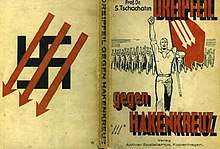Three Arrows



The Three Arrows (German: Drei Pfeile) is a social democratic political symbol. The symbol emerged in Germany in the midst of the political crisis that preceded the National Socialist takeover in 1933.
Overview
The Social Democratic Party of Germany was challenged by both the National Socialist German Workers Party and the Communist Party of Germany. In this setting, the Social Democratic Party organizer Carlo Mierendorf recruited Russian exiled physiologist Sergei Chakhotin as the propagandist of the paramilitary Iron Front, and together the two developed propaganda initiatives to counter the national socialists and the communists in early 1932. Together the two launched the 'dreipfeil' as a symbol for the socialist militancy.[1]
Mierendorf and Chakhotin launched the 'Three Arrows against the Swastika' (Dreipfeil gegen Hakenkreuz) campaign.[2] Chakhotin authored a book by the same name.[3] The three arrows were fought to represent the struggle of the socialist movement against reaction, capitalism and fascism.[4][5] On an election poster of the SPD for the Reichstag election on 6 November 1932, the 3 arrows stand for the enemies of democracy: monarchists, communists and National Socialists.[6]
The aesthetic of the campaign, and the 'dreipfeil' symbol as such, drew inspiration from Soviet Russian avant-garde revolutionary artwork.[2] According to Chakhotin, he found inspiration for the 'dreipfeil' from a swastika that had been crossed over by chalk in Heidelberg. Per Chakhotin's argument, with the three arrows and the swastika, it would always appear as the three lines would have been imposed over the swastika rather than the other way around.[1]
The 'dreipfeil' was adopted as an official socialist symbol by the Social Democratic of Germany leadership and the Iron Front by June 1932.[1] Iron Front members would carry the symbol on their arm bands.[7]
In August 1932, the Austrian social democrats adopted the three arrows as their 'combat symbol'.[5] The Austrian socialist poet Karl Schneller dedicated the poem 'Drei Pfeile' to the 1932 Austria Social Democratic Party congress.[5] The symbol was banned in Austria in 1933.[4] During National Socialist rule, the symbol appeared on pamphlets of the Revolutionary Socialists of Austria and was used in graffiti.[5] During 1932-1935 it was also used in Belgium, Denmark and the United Kingdom.[1][2] After Chakhotin had been forced into exile to France, the symbol became used by the French Section of the Workers International.[1]
After the Second World War, the three arrows became the official party logo of the Social Democratic Party of Austria in 1945. The symbol had been modified to include a circle, and the symbolism changed to represent the unity of industrial workers, farm workers and intellectuals.[4] The three arrow symbol remained a prominent Social Democratic Party of Austria symbol until the 1950s.[4]
The Three Arrows remained the symbol of the French socialists until the 1970s, when it was substituted by the fist and rose symbol.[8]
References
| Wikimedia Commons has media related to Drei Pfeile. |
- 1 2 3 4 5 Dan S. White (1992). Lost Comrades: Socialists of the Front Generation, 1918-1945. Harvard University Press. pp. 94–95. ISBN 978-0-674-53924-2.
- 1 2 3 Richard Albrecht (2007). 'Dreipfeil gegen Hakenkreuz' - Symbolkrieg in Deutschland 1932. GRIN Verlag. p. 2. ISBN 978-3-638-67833-9.
- ↑ Michael W. Berns; Karl Otto Greulich (2007). Laser Manipulation of Cells and Tissues. Elsevier Academic Press. p. 731. ISBN 978-0-12-370648-5.
- 1 2 3 4 Drei Pfeile
- 1 2 3 4 Bund Sozialdemokratischer Freiheitskämpfer/innen, Opfer des Faschismus und aktiver Antifaschist/inn/en. Unser Zeichen
- ↑ politische-verfolgung-moerfelden.de
- ↑ Georg Franz-Willing (1982). 1933, die nationale Erhebung. Druffel-Verlag. p. 20. ISBN 978-3-8061-1021-0.
- ↑ Annette Becker; Evelyne Cohen (2006). La République en représentations: autour de l'œuvre de Maurice Agulhon. Publications de la Sorbonne. p. 44. ISBN 978-2-85944-546-1.